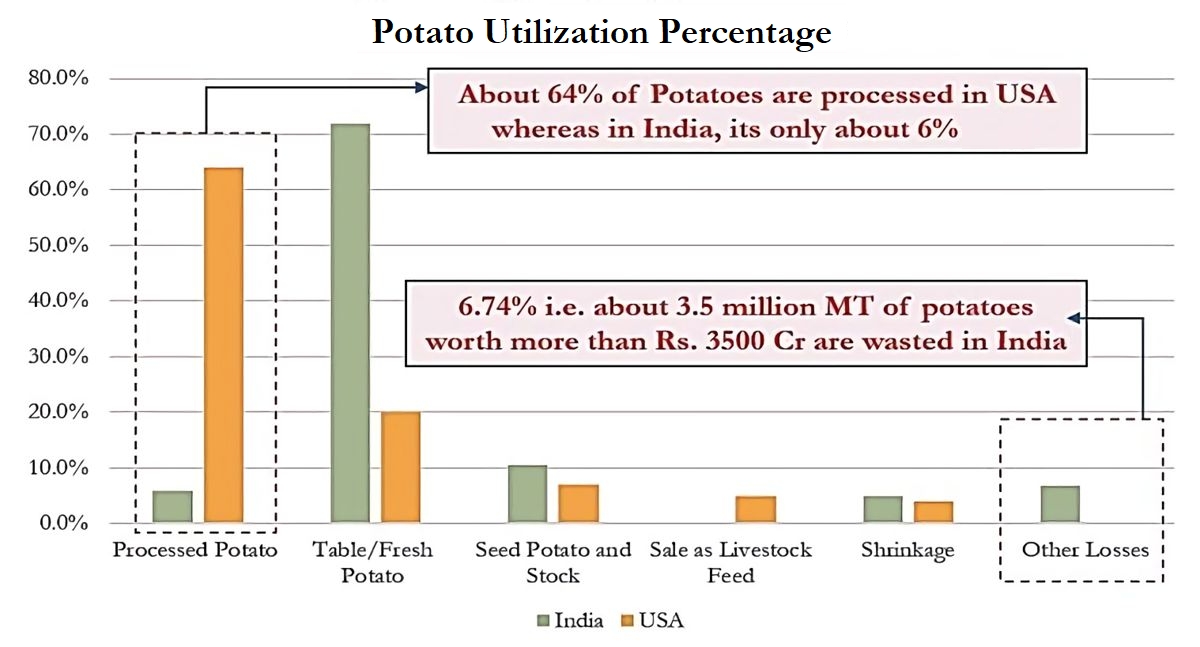|
|
| 17 jun 2022 |
12:04 |

|
hero role for potatoes in global food security?
These events have disrupted all four indicators of food security i.e., food availability, food access, food use, and quality as well as production stability. The world population is estimated to reach about 9.7 billion wherein people will demand 70% more food than is consumed today (FAO, 2018). The additional demand will further put immense pressure on the already fragile global agri-food system.
|
|
The global agri-food system has been struggling with a series of disruptions caused by various events, including drastic climate variabilities, the global pandemic of Covid-19 outburst, and the recent among them is the Russia-Ukraine war.
These events have disrupted all four indicators of food security i.e., food availability, food access, food use, and quality as well as production stability. The world population is estimated to reach about 9.7 billion wherein people will demand 70% more food than is consumed today (FAO, 2018). The additional demand will further put immense pressure on the already fragile global agri-food system.
With a heavily skewed global production and trade ecosystem of the agri-commodities, especially wheat and paddy, critical to food security, the world is at greater risk of experiencing acute hunger. The same is also validated by The Global Food Crisis Report which states that 193 million people from 53 territories have experienced acute hunger, which is 20.7% more than the preceding year.
Role of Potatoes in ensuring food security
Historically potato has played a critical role in not just ensuring food security for the existing population but also in supporting further growth of the global population. It has always been a reliable food source during testing times like war, famine, etc.
It is a source of comprehensive and balanced nutrition with the presence of not just carbohydrates but protein and a range of minerals etc. also.
Currently, It is the third-largest crop globally with a total production of 359 million MT cultivated across 16.5 million MT and 158 countries of the world. A considerable portion of total production happens in Asia, Africa, and Latin America. These are the regions wherein food security is a pressing concern.
Potato is grown in a wide range of agroclimatic conditions, making it cultivable across wide-ranging countries across the world. It is estimated that the total production of potatoes will increase by 750 million MT by 2030 mainly on account of an increase in yield and area of cultivation mainly across Asia, Africa, and Latin America.
It would require concerted efforts towards further strengthening the potato agri-food system by ensuring a system that is remunerative for all the stakeholders which are involved in it starting from producers to retailers and consumers. Additionally, they need to further promote area expansion and R&D in new variety of development.
Impact of Ukraine-Russia War on Potato Cultivation As per the latest data available with FAO, Ukraine is the third-largest producer of potatoes with a production of 20.8 million MT in 2020 (FAOSTAT, accessed 30th May 2022). The production is not sufficient as Ukraine further imports about 0.3 million MT to fulfil its domestic consumption mainly from Poland, Lithuania, and Romania.
The ongoing war between Ukraine and Russia will not only result in a drastic reduction in local potato production in Ukraine but would also result in higher post-harvest losses as many potato warehouses have been destroyed by Russian Military forces.
Additionally, the cost of agrochemicals has also gone up, especially in Europe, broadly because of considerable dependence on Russia for its manufacturing and increased fuel cost. Increased agri-input costs and their unavailability is incentivizing farmers to shift to alternative competing crops like wheat etc.
As per the new release by Northwestern European Potato Growers, planted area in Europe has decreased first time in two decades. It has decreased by 4.7% to 497K Ha under the cultivation of potatoes. Wherein a major decline has been observed in the Netherlands and Belgium.
Role that India potato stakeholders in stabilizing global potato agri-food system towards boosting food and nutrition security
India, so far, has largely been isolated from any impact of the Ukraine-Russia war as far as potato cultivation and marketing are concerned. Potato production in the current crop year is estimated to be 53.60 million MT, down from 56.17 million MT according to the Ministry of Agriculture's first estimate of horticulture production (PotatoPro May 12, 2022).
The reduction in production quantity is largely due to heavy rains, especially in Bengal, Punjab, and Haryana, and also due to heat waves during the harvest season in UP. Though increased fuel cost and possible disruption of the flow of critical agrochemical can impact the upcoming rabi cultivation season in India.
Special emphasis is needed on these fronts to ensure a smooth flow of agri-inputs at affordable prices to shield Indian farmers from the negative externalities of the ongoing Ukraine-Russia War. The ongoing crisis has unveiled the structural issues in the potato food system across the world which is destabilizing it.
It presents India with the opportunity to come to the fore and play a critical role in ensuring alternative channel development of the potato food system to mitigate the dependence of the world on specific grain crops and specific geographies in ensuring food security for the world in times to come.
With 53 million MT of production, India is second in the world in potato production. Yet, there is immense scope to further increase production by area expansion and improved productivity. It is grown in more than 15 states across various seasons in India.
There are a few structural issues that need to be addressed to integrate India with the world’s potato food system. Reducing Post-Harvest Losses, Currently, they lose about 3.5 million MT on account of post-harvest losses. The same is close to zero for the USA and other developed countries.
They can substantially reduce the same by incentivizing the adoption of the latest technologies in post-harvest management and localization of production clusters.
Incentivizing private sector to breed new seed varieties, India has about 13-15 commercially popular varieties of potatoes whereas the USA has more than 200 and the Netherlands has more than 62 commercially popular varieties. They need to put efforts into commercializing climate-resilient and market-demanded varieties of potatoes.
It will require considerable R&D work to be undertaken independently and also in collaboration with International seed potato growers. In this area, they actively need to incentivise the private sector to breed new seed varieties which would cater to changing climate and specific market needs.
Indian companies have been breeding new seed varieties for example a low G.I. variety named ‘SV Agri Carisma’, a rot-resistant variety named SV Agri Ganesh, and a variety with high zinc and iron named SV Agri Winner etc. Though the same need to be systemically incentivized to expedite the process. There is also a need to explore the potential for allowing genetically modified potatoes to further boost the potato-based agri-food system.
Promoting Cultivation of Internationally demanded varieties to boost its exports: They, as a nation, need to promote the adoption of the varieties that are acceptable in the international market to boost exports of fresh potatoes. It will act as a risk-mitigating factor by reducing the dependence of trade on a selected set of countries.
Productivity improvement, Average yield of potatoes in India i.e., 23.7 MT/ha is greater than that of the global average yield of 21.7 MT/Ha. There is still a huge scope for improvement in yield as India ranks 56th in the yield of potatoes.
Countries across various agroclimatic zones i.e., from Europe, America, Middle-East Asia, and South Asia have productivity better than India. Concerted efforts need to be made on improving the seed replacement rate as well as the package of practices in potato cultivation.

Countries with potato productivity greater than India
Increasing processing capabilities, Additionally India is grossly under-leveraged as far as the processing of potatoes is concerned to fulfil its domestic demand as well as cater to the ever-growing export potential of processes potatoes. Currently, India process about 6% of its total potato production whereas USA process about 64% of its potato.

Potato utilization percentage
There is a need to structurally incentivize the promotion of processing a variety of potato clusters as well as processing facilities across India. Various value-added potato products with huge market potential are chips, fries, frozen fries, flakes, powder, starch, and protein as well as ethanol.
It will strengthen the potato value chain in India by making it more remunerative for stakeholders across the chain. It will reduce arbitrage-based trading of potatoes in India and promote a value addition-based trading system thus making it more reliable for international buyers to procure potato and value-added potato products from India.

|
|
|
|
